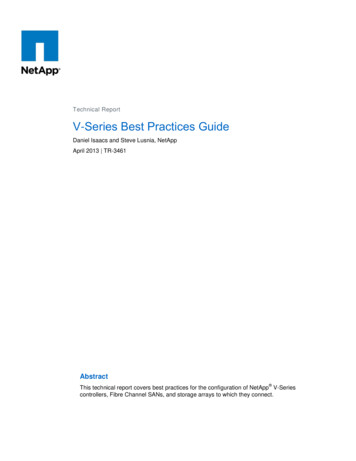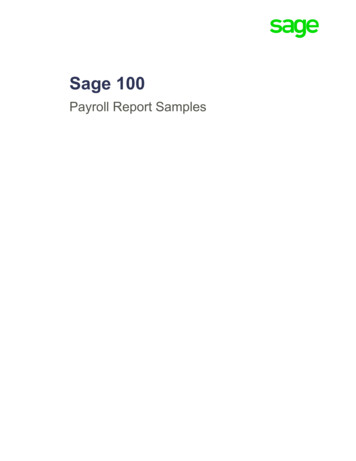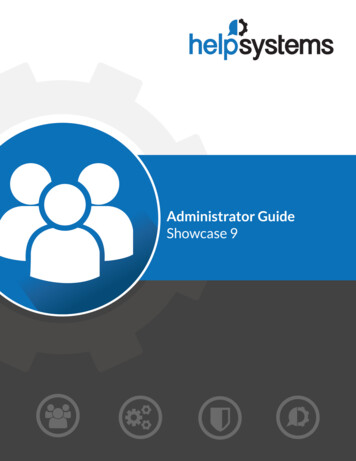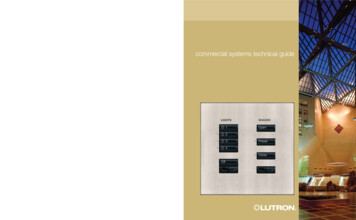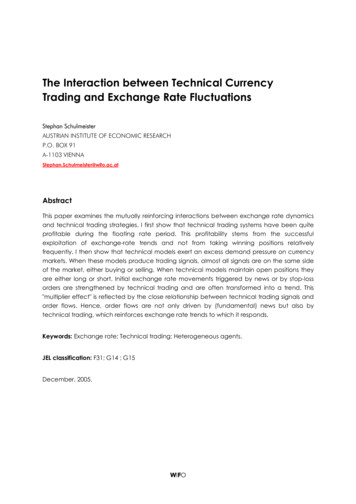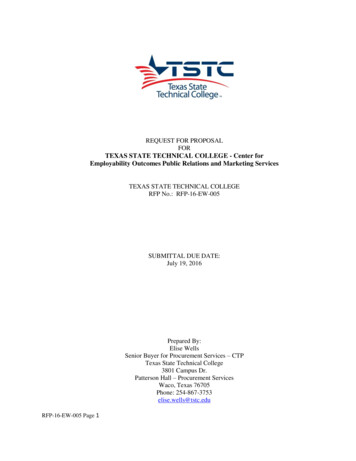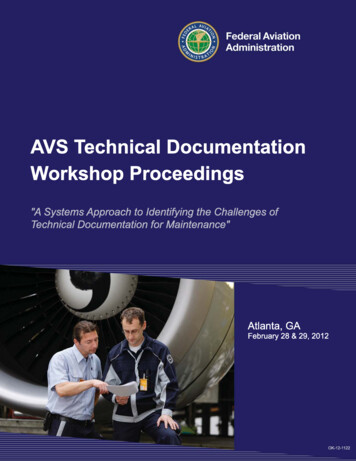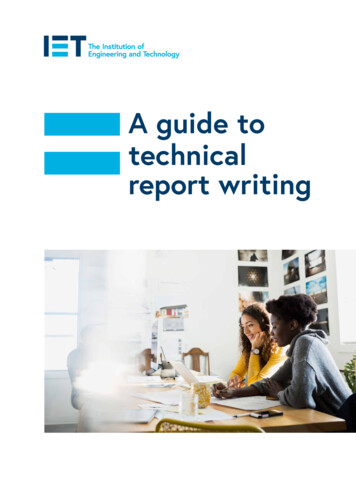
Transcription
A guide totechnicalreport writing
A guide to technical report writing – ContentsContents1. What makes a good technical report?32. Objectives42.1 Who are you producing the report for?43. Format53.1 Appendices3.2 Sections and subsections3.3 References5564. Writing74.1 Spelling4.2 Punctuation4.3 Sentences4.4 Paragraphs4.5 Formality4.6 Example7778885. Diagrams95.1 Positioning5.2 Tables5.3 Graphs5.4 Diagram references99996. Finishing the report106.1 Summaries6.2 Abstracts6.3 Table of contents6.4 Title page6.5 Appearance6.6 Checking1010101010107. Resources1102
A guide to technical report writing – What makes a good technical report?A Guide to Technical Report Writing was originally written by Joan vanEmden and the late Jennifer Eastel and has been revised by the IET,with input from Alex Kerr who delivers this course on behalf of the IET.1. What makes a goodtechnical report?A good report is easy to recognise. Its title is preciseand informative and its format logical to the reader,with headings to indicate the content of each section.Diagrams are well-presented and clearly labelled.Keep these rules in mind and you will be more likelyto attract readers, direct them towards relevant,clear information and steer them towards the desiredresponse.There are no absolute rules on report productionbecause every report must be adapted to the needs ofits reader. This guide, however, suggests that there arelaws of good report writing which should be generallyapplied (but broken if necessary).Notice that the first law is repeated because it’s a lawwhich shouldn’t be broken. Taking shortcuts to savetime and money are counterproductive if your reader isleft confused by the report or decides it’s too difficult towork out what you are trying to say.10 laws of good report writing1. produce the report for yourreader(s)2. keep the report as short as possible3. organise information for theconvenience of the reader4. include accurate references5. ensure your writing is accurate,concise and straightforward6. include diagrams with the rightlabels in the right place for yourreader7. make sure your summary gives thewhole picture in brief8. check the report for technicalerrors, typing errors andinconsistency9. consider design as well as content10. produce the report for yourreader(s)03
A guide to technical report writing – Objectives2. ObjectivesSet the objectives for your report before you startwriting. Note them down and check that you arekeeping to them, even during the last stages ofproduction.2.1 Who are you producing the report for?Your objectives should identify:If you want your report to make an impact, you needto consider your reader. Knowing your reader shoulddetermine your approach, the technical content andstyle of your writing.– who you’re producing the report forAsk yourself:– why you’re producing the report– What does the reader already know about thesubject?– what information you’re covering– What do you need to tell the reader?What happens without clearobjectivesIf you don’t take time to clarify yourobjectives, writing the report will bemore difficult, understanding it evenmore so and you may not achieve thedesired response.A report which was meant to coverthe UK, but instead just dealt withEngland and Wales resulted in lostopportunities for development andsales in Scotland and Northern Ireland.A report which tried to be both aspecification of a machine and a reporton the results of using a machineleft readers in confusion, as it didn’tprovide a precise specification or asatisfactory conclusion.– Why does a particular reader need this particularreport?– What is the desired response from the reader?– How can you bridge the gap between what thereader knows already and what they need toknow, in order to produce the desired response?– What level of formality is appropriate? (e.g. ashort emailed report to a colleague will be lessformal than a report for a managing director ofanother company)Reports are often written for multiple readers, forexample, technical and financial managers. Writingtwo separate reports would be time-consuming andrisk offending people who are not party to all of theinformation. One solution to this problem is strategicuse of appendices (see page 5).04
A guide to technical report writing – Format3. FormatOnce the objectives have been established, startorganising the information available. As you findmaterial, put it into one of three categories:1. important information that is relevant to theobjectives2. borderline information which might be usefulto some readers or support more importantmaterial3. information which may be interesting to you,but is not relevant to the objectivesSet aside category 3 material to check it later. Materialin categories 1 and 2 must be kept available andthought of as probable main text (category 1) andappendix material (category 2).When you’ve identified probable main text, you canstart looking through it to decide on how it could beordered logically.3.2 Sections and subsectionsDivide information and place it under headings that areas specific as possible. From a visual point of view, thisspace on the page makes your report easier to read.Also, readers can identify and refer to sections whichare relevant to their interests.Section headingsIf you don’t have a template for a report provided byyour company or university, then there are some widelyaccepted section headings you can use:– Title page– Acknowledgements– Summary– Table of Contents– Introduction/Terms of Reference/Scope3.1 Appendices– ProcedureAlthough appendices are at the end of a report, thinkabout them first as they can be one your most usefultools. Appendices should be used to remove from themain text all information which is not needed by themajority of readers.– Findings– Conclusions– Recommendations– References/BibliographyIf the main text is clear of detailedstatistics, maps, explanations oftechnical terms or experimentaldata, it will be kept as short and asreadable as possible.By using appendices, you can also caterto different types of readers, theirneeds and priorities. Experts may feelpatronised by too much explanationin the main text and non-experts leftconfused by lack of information – butappendices can satisfy both parties.– AppendicesThese sections can be adapted or merged together,depending on what you think would be appropriate foryour reader. They form a framework for a report, but youdon’t need to start writing at the beginning. Writersoften find it easier to start with the factual material inthe Findings section.NotationThe logical linking of headings is shown by notation,usually decimal notation. The system is easy to produceand follow, and the fact that it is widespread meansthat readers are likely to be familiar with it.An engineer may be frustrated bytechnical information interwoven withdetails of costing, but both technicaland financial readers will be happy tofind costings in the appendix.05
A guide to technical report writing – FormatHeadings should match the numbering in importance,so a main heading should have a major notation (asshown below):1. MAIN HEADING1.1 Lesser Heading1.1.1 Small heading8. MAIN HEADING8.4 Lesser Heading8.4.6 Small HeadingThe heading numbered 1.1.1 should be equal inimportance to heading 8.4.6. Ideally notations shouldhave no more than four numbers, as more subdivisionsare difficult to follow.Appendices should be distinguished from the main textby a letter, and if necessary, a decimal notation after theletter:Appendix B2.4This is the fourth subsection of the second majorsection of the second Appendix.3.3 ReferencesAccurate references improve the credibility of yourdocument, making your report more convincing. Make anote of references as you go along, so you don’t forgetwhere your information came from, as that’s whereerrors can creep in.There are various referencing systems and you shoulduse the system preferred by your company or university.If you don’t have guidance on referencing, a couple ofoptions are shown below.In-text citingIn the text, references are shown by a number in squarebrackets [1] and the full references are listed in order atthe end of the report:1. Van Emden, J. (2005). Writing for Engineers.3rd ed. Basingstoke: Palgrave Macmillan.2. Hawley, R. (1996). Leadership challenges in anengineering environment. EngineeringManagement Journal, 6 (5), pp. 217-231Harvard referencingIn the text, the author’s surname and the date (Hawley,1996) are included, and at the end of the document, thedetails are given in full:Van Edmen, J and Becker, L. (2017). Writing forEngineers (Macmillan Study Skills). 4th ed.Basingstoke: Palgrave Macmillan.Hawley, R. (1996). Leadership challenges in anengineering environment. Engineering ManagementJournal, 6 (5), pp. 217-231.For online materials, cite them in the same style asother bibliographical sources, but indicate it is onlineand provide the URL and the date accessed.The IET, (2019). The Institution of Engineering andTechnology’s official website. [online] Available athttp://www.theiet.org [Accessed 13 Mar. 2019].06
A guide to technical report writing – Writing4. WritingA well-written report is easier to read,makes your meaning clear and builds thereader’s confidence in what you are saying.4.1 SpellingWhen you’ve completed a section of the report, checkit for spelling errors. If you’re relying on a spellcheckerprogramme, watch out for the following errors whichmay not be picked up:– Using the wrong wordIf you use a word which was not intended, aspellchecker will often accept it. ‘Not’ and ‘now’,for instance, are easily confused.– Technical wordsThese words need to be checked carefully as aspellchecker programme often has no adviceon them.– New technical wordsNew technical words or semi-technical words oftenstart out as two words, then become hyphenated,before finally becoming accepted as one word. Forexample, cyber-security/cybersecurity, e-mail/email.Look to the technical press, such as IET journals, forguidance on these words. Where both variants arestill used, go for one word, as hyphens tend toclutter up the text.4.2 PunctuationCommasCheck your use of punctuation, such as commas, as itcan transform the meaning of sentences. For example:The engines, which were in perfect running order,had been tested previously. (all engines were inperfect running order and had been tested)The engines which were in perfect running order hadbeen tested previously. (only the engines in perfectrunning order had been tested)HyphensDo use hyphens if not using them will lead to ambiguousmeaning, e.g. ‘a cross-section of staff’ vs ‘a crosssection of staff’. They should also be used to form shortcompound adjectives. e.g. three-year plan, two-tonnevessel.4.3 SentencesGood style involves varying sentence length. A longtechnical explanation, which mentions somewhere in themiddle that maintenance costs can be reduced, risks theimportant point being lost.Short sentences provide a clear, easy-to-read style forfactual information. Where information needs to becompared with other information, longer sentences canwork better.07
A guide to technical report writing – Writing4.4 Paragraphs4.6 ExampleParagraphs should unify content, but also be used tomake the document more readable. Several paragraphson a page with resulting spaces encourage reading,while a long block of text is off-putting.Below is an example of writing by a qualified andexperienced engineer, followed by our suggestion forimprovement.4.5 FormalityReports are formal documents, but that doesn’t meanyou have to use overly complex words or grammar. Usesimple words that you’d use in everyday conversationto get your meaning across, e.g. ‘send’ rather than‘dispatch’ and ‘finish’ rather than ‘draw to a conclusion’.If you choose more complex language, readers could beunnecessarily distracted by it.Writing in an impersonal style can also make sentencesdifficult to read, e.g. ‘It was immediately apparent to thewriters.’ If your company or university policy permits,use the more straightforward active voice: ‘I recommend’or ‘We recommend’.For more information on spelling, grammar and style, seeour resources on page 11.At present on the XYZ sub-station we have nofacility to supply 12000 amps required for the newplant from the existing spare O.C.B.’s, this willrequire the removal of some of the old existing oilcircuit breakers and replacing with new vacuumcircuit breakers (VCBs) since we cannot uprate theexisting VWX equipment which is of course 1937vintage, the proposal for this would be as follows.Revised example:On the XYZ sub-station board, we are unable atpresent to meet the demand (1200 amperes perphase) required to operate the new plant using theexisting oil circuit breakers (OCBs). Spares are notavailable and the old equipment cannot be uprated.We therefore suggest replacing some of the existingswitchgear with new vacuum circuit breakers (VCBs).The proposal is costed below.1. move ‘at present’ so emphasis is on the sub-station board2. replace unnecessarily complex language ‘we haveno facility’ with ‘we are unable to’3. amps is not a recognised abbreviation foramperes4. spell out acronym before using it (OCB)5. break up text into shorter sentences andparagraphs for ease of reading08
A guide to technical report writing – Diagrams5. DiagramsDiagrams — which include tables, graphs,photographs and line drawings — are anessential part of many technical reports.They can summarise a lot of information orclarify a situation or complex details in a waythat continuous text can’t.5.1 PositioningMost readers do not like to have their readinginterrupted to search for a related diagram. They areunlikely to stop reading, turn the page or pages tolook at a diagram and then return to their place in thetext. Instead, they will mentally register the reference,continue reading and will study the diagram, if at all,only when the information in the diagram becomesessential.If you want readers to pay attention to your diagrams,you need to position them in the right place —where they are needed. That means positioning adiagram close to the text that refers to it, or if it issupplementary information only, in an appendix.5.2 TablesTables can bring together a great deal of information forthe reader when presented effectively. The use of space,in particular, can make the table easier to read.Tips for creating space in your tables– Put units and powers of ten in column headings– Group together similar items, e.g. in annualfinancial breakdown, you could group togethermonths in quarters (January-March)– Think about how much detail your reader needs.Do they need the exact figures or can they berounded? Do they need all the data or can somebe omitted/put in an appendix?5.3 GraphsGraphs are used to show trends or give accuratetechnical information. If graphs are to be compared, usethe same scale for each.5.4 Diagram referencesDiagrams of all types must be clearly referenced in thetext. Use the first number of the section in which thediagram appears, and then after the decimal point,the sequential number, e.g. Figure 3.7 is the seventhdiagram in section three of the report.Checklist for diagrams– Does it give the reader therequired information?– Is it easy to use?– Does it look attractive?09
A guide to technical report writing – Finishing the report6. Finishing the report6.1 Summaries6.4 Title pageA summary gives a general picture of the report forthose who want to be reminded of what they have reador for those who will never read the whole report.As the title page is the first page that the reader willsee, make sure it includes the relevant details:It makes the report’s ‘answer’, its conclusions andrecommendations immediately available. For this reason,it’s the section that is read by the majority and the mostsenior readers (often the decision makers) who mightnot have the time or interest to look into the detail.Tips on writing your summary– Keep it under 250 words for a report of up to 50pages. You may need to start with too manywords and edit down.– Give enough background information for yoursummary to make sense to a reader who hasn’tread the whole report.– Comment on major findings and highlightconclusions of importance.– Use continuous prose — diagrams in summariesare rare.– Title– Author’s name– Report reference number– Date– Classification (confidential, etc) if appropriate6.5 AppearanceOvercrowded pages, small typeface, headings whichmerge with the text — all these put readers off and mayeven prevent them from becoming readers. Think aboutgood layout, print and plenty of space – readers areencouraged to tackle even the dullest subject if pagesappear clear and easily digestible.6.6 CheckingAbstracts are used to bring together the report andpotential readers, attracting readers who might notnecessarily consider the report relevant to them.Give your report a final check, as an error-free documentwill strengthen its credibility. Where possible, ask twopeople to check your report — a technical expert whocan assess the amount of explanation given, the validityof data and the logical flow of information, and a nonexpert who can check for spelling/grammar errors.The abstract selects areas of interest covered by thereport and may include a list of key words, so that yourreport is more discoverable.If you’re checking your own work, do it with fresh eyes.Leave the report for at least 48 hours after writing it,before you give it that final check. Then it’s ready to go!6.2 Abstracts6.3 Table of contentsList each chapter or section with its constituentheadings, section and sub-section numbers, as wellas page numbers. This helps the reader to select aparticular sub-section of interest and find it easily, atthe same time as seeing its connection to what comesbefore and after it.10
A guide to technical report writing – ResourcesResourcesCutts, M. (2013). Oxford Guide to Plain English (Oxford Paperback Reference).4th ed. Oxford: Oxford University Press.Van Edmen, J and Becker, L. (2017). Writing for Engineers (Macmillan Study Skills).4th ed. Basingstoke: Palgrave Macmillan.The Guardian and Observer style -observer-style-guide11
Our officesLondon, UKT 44 (0)20 7344 8460E faradaycentre@ietvenues.co.ukStevenage, UKT 44 (0)1438 313311E postmaster@theiet.orgBeijing, ChinaT 86 10 6566 4687E china@theiet.orgW theiet.org.cnHong KongT 852 2521 2140E adminap@theiet.orgBangalore, IndiaT 91 80 4089 2222E india@theiet.inW theiet.inNew Jersey, USAT 1 (732) 321 5575E ietusa@theiet.org@TheIETtheiet.orgThe Institution of Engineering and Technology (IET) is working to engineer abetter world. We inspire, inform and influence the global engineering community,supporting technology innovation to meet the needs of society. The Institutionof Engineering and Technology is registered as a Charity in England and Wales(No. 211014) and Scotland (No. SC038698). Michael Faraday House, Six Hills Way,Stevenage, Hertfordshire, SG1 2AY, United Kingdom.
A guide to technical report writing – What makes a good technical report? 03 10 laws of good report writing 1. produce the report for your reader(s) 2. keep the report as short as possible 3. organise information for the convenience of the reader 4. include accurate references 5. ensure your

